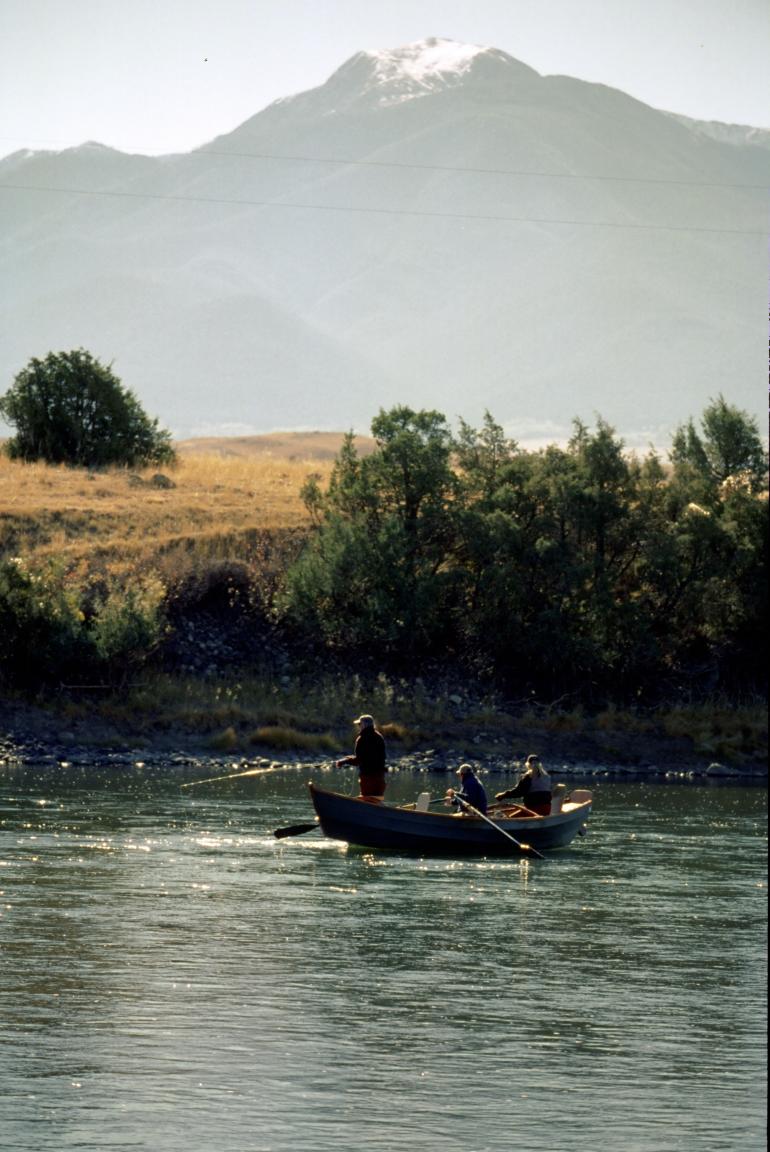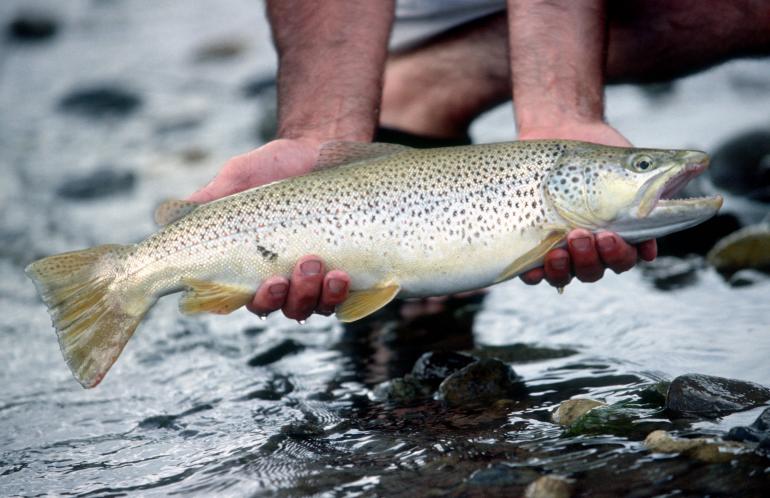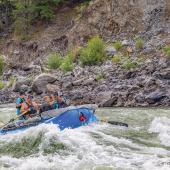Fat Fish and Good Grub
Secrets of fishing the Yellowstone.
It would become a perfect day. One of those rare days when the air feels neither warm nor cool; not clammy, but not noticeably arid either. An air temperature so ideal that until you think back on it, at the end of a day spent outdoors, you don’t notice it.
However, just the previous afternoon my sister and I had marveled at the torrential downpour. Actually, it was more of a sideways pour, punctuated by brilliant bolts of lightning and rumbling thunder, making for a cold and dark August day. This did not bode well for fishing the next morning. We considered calling Molly, who was to guide us on the Yellowstone, but decided to let her be the one to cancel. Later that night, as if to underscore that wild swings in barometric pressure were not enough to put down every single fish, the earth shook: a 5.6 magnitude centered in Dillon. It occurred to me that if we felt the tremble, certainly the fish had also and were just then seeking their deepest and darkest hiding waters.
“You’ll learn two things from me today,” Molly assured us. “I can’t tell you what they will be, but you’ll learn at least two things.” I did not know what I would learn about fishing or casting, but she had me. I paid attention.
I had only met Molly an hour before, when she stood to greet my sister and me in Hatch Finders Fly Shop. She was tall and calmly effusive, and I immediately felt at ease with her. We spent some time in the shop that bright morning focusing on flies, learning what was working on the river, planning the day’s fishing, and filling our boxes with Dean Reiner’s excellent flies. Then we transferred gear, headed off to Matt’s Old Fashioned Butcher Shop for our lunch sandwiches, and made for the river.
“Don’t help unless I ask for it,” Molly instructed us. “A guy actually ran himself over doing just this,” as she skillfully dropped her drift boat down a steep access to the wide Yellowstone River. “I wouldn’t want anything like that to happen to you.”
The boat was loaded with coolers, rods, and gear bags, and we shoved off. Jitters about the day’s fishing flooded my head. This is the Yellowstone, after all. I don’t get to fish it every day. Once in two years is more like it. How would I do? Would I embarrass myself casting? Hook my sister? What gear had I forgotten? Though I knew the water was too big for it, I wished I had my four-weight.
But the water took over as the boat entered the current, and my anxieties dissolved. I looked around to soak in the moment. It had been a wet year for southwestern Montana, the wettest on record, and it showed. Hints of green blushed the hillsides of broad Paradise Valley, the rivers were full, and there were few wildfires. The shoulders of massive Emigrant Peak were draped in green hues, and the earth had a gentle and easy appearance in contrast to its usual harsh August browns.
There was no one else on the river. No other boats to contend with, and only an occasional deer peeking out from lush riverside vegetation to curiously spy on us. Molly, master of boat handling; my sister at the bow; and I comfortably situated in the stern seat, taking it all in. I liked being back there where my casting would not be on exhibit. When she wasn’t caught up with pointing out where to cast, Molly was relating stories about everything to do with fishing: her first fish, caught for her father; why NOT to rest your rod on the car roof; the daily insect cycle of this particular stretch of water.
That morning we caught, admired, and released colorful and fat trout. We admired leaping Rainbows, and we cast to finicky risers. Always we turned back to the insects. Molly seined the water, and we did our very best to match artificial flies to the living counterparts that showed up in her net.
At lunchtime Molly eased the boat ashore. She had chosen a comfortable grassy picnic spot. While my sister and I casted to risers, Molly arranged the table (complete with checkered table cloth and napkins featuring dry fly and nymph patterns), chairs, and our lunch. We had cookies, fruit, chips, pasta salad, and ice-cold lemonade. And then there were those sandwiches.
Matt says they are good because he uses only the freshest and best ingredients. He uses kosher pickles, and he packs the tomatoes on the side so that they don’t make the sandwich soggy. That day, ours were loaded with turkey, cheese, lettuce, pickles, onion, whole grain mustard, and freshly baked sourdough bread. The turkey is custom-smoked there at his shop.
Matt’s Old Fashioned Butcher Shop is located on a side street in Livingston. The store has an unassuming outward appearance because Matt’s is all about one thing: meat. One wall is entirely covered in awards, beautifully mounted plaques in red and blue metal shaped like the state of Montana and attached to walnut rectangles. There are about 60 of them and he’s only been in business since 1996. Matt is modest about his accomplishments. In three years as an apprentice in California, he learned from a German butcher that by varying the texture of sausage as well as the spices he could produce interesting and varied flavors. When I asked him what had made him so successful, he was humble: “Just lucky, I guess.”
Although Matt’s store is a little off the beaten path, Molly concedes that a more central location might pose problems for the custom butcher. Through the fall and winter, Matt processes around 600 game animals. The carcasses stacked in his parking lot might make the tourist bureau a little nervous.
Back on the river, we delighted ourselves with the final sandwich crumbs before clambering back into the boat for a quiet afternoon of floating and fishing. As I settled back into my comfortable casting position, I found myself mulling over the day as the landscape passed behind us and the river carried forward. Molly was absolutely right: I had learned at least two things from her this lovely day. Among them, I learned the oval cast; how to tell whether a fish is feeding on caddis or mayflies just by the sound it makes; the three most important characteristics of matching hatching insects, and that seining the river is probably your most important activity on the water. And I learned that there is a good deal more to a great lunch than bread and a slice of meat.
Months have passed since our day on the big river, and I still revel in the rich and vivid memories of a day filled with fat Yellowstone fish, a delicious meal, and good conversation about casting, matching flies, and other aspects of fly fishing. It simply does not get much better.
Contact fishing guide Molly Semenik at 222-1881 or visit tietheknotflyfishing.com; call Matt Feldtmann at 222-5160.
Hiring a Guide
by Kurt Dehmer
Did you skim the title of this article? Perhaps scoff at the notion of actually hiring someone to take you fishing? Do you subscribe to the notion that fly fishing guides are only for tourists and newcomers, and only the wealthiest of those at that? On your last trip to the river, did you grumble about too many guides, too many people, or a combination thereof? While we’re on the subject, did you learn something new your last time on the water: maybe a new fly pattern, a technique, or a little-known piece of Montana’s rich cultural or biological history? How many fish did you catch? Did you make a memory, or perhaps connect with your kids or spouse in a new way? The last time you went fishing, did you come home a better angler? Answer those questions honestly, then head on over to your favorite fly shop, book a trip, and then sit back, relax, and have fun.
One of my best clients, a valley native of a couple generations, hires me a minimum of three times a season. According to him, it’s just easier to let me do all the “work stuff” that comes with a day on the river. What he means is that he can actually take the day off, no worries about rowing, picking the right fly patterns, packing a lunch, driving to the river, hiring a shuttle, etc. etc. Simply put, he can just fish and enjoy his day, more or less hassle-free. Sounds kinda nice, doesn’t it? Not to mention that when company comes, you can actually fish while the guide works on their casting or answers all their questions. Plus the in-laws or anyone else can vastly defray the cost of the day.
Cost is the lynchpin that usually deters most folks from hiring a guide. For a moment let’s examine the cost of a day-long guided float trip. On average, most outfitters in this area charge about $375 to $400 for a full-day float trip for two anglers. Now just hold on to your sticker-shock for a bit; let’s examine the cost if you were to do it yourself:
Drift boat / frame raft: $1,200-$10,000
Gas to and from river: $35-$100 and rising
Lunch: $25
Shuttle: $15-$35
So far, even with the most inexpensive scenario you have already spent $1,275. Not to mention the upkeep on the boat, the rig, or the divorce lawyer you’ll surely need when your wife finds out you spent nearly two grand just to take your uncle Bud out fishing for the day. Let’s also not forget that unless all your in-laws and buddies are experienced rowers, you are going to be doing all the oar time as well. Consequently you don’t get to fish. That $375 isn’t looking so outrageous now, is it?
Not to mention that you can’t put a price on experience. Guides spend their days on the water, and they know the what, where, and how of the waters they fish. That is above all the best reason to hire a guide. So if you want to learn more about your favorite waters, and enjoy your day off, we guides are waiting to hear from you.
Kurt Dehmer owns Durty Kurty's guide service and guides for Lone Mountain Ranch and The Bozeman Angler.
Ennis Fly-Fishing Festival
As temperatures fall and kids head back to school, many dread the beginning of September as a death sentence to summer. Fly fishers, on the other hand, tend to whistle a different tune. This year welcomes the fourth annual Ennis on the Madison Fly Fishing Festival, with three days dedicated to the beauty and precision of the sport and attracting enthusiasts from all over the country.
This year’s event takes place September 1-3 and includes casting clinics, fly tying demonstrations, casting contests, and presentations from nationally recognized fly fishers. Currently invited are Ted Leeson, Bob and Cezanne Alexander, Kelly Galloup, Dick Greene, Ken Morrish, Scott Sanchez, and Greg Thomas. As no festival is complete without delicious grub, there will be a variety of taste treats, including a classic barbeque. Art galleries and music add another dimension of culture, with past musicians coming from as far away as Nashville and Los Angeles. This year Tennessee-based singer/songwriter Juni Fisher takes the stage as the featured artist.
More important than fishing, food, and music, though, is the underlying conservation theme. Representatives from Ennis National Fish Hatchery, Big Hole Foundation, Madison Valley Ranchlands Group, Montana Department of Fish, Wildlife, and Parks, Rocky Mountain Elk Foundation, Trout Unlimited, and U.S. Forest Service came in past years. So instead of mourning the end of summer, bring your rod down to Ennis and enjoy the fall fishing. Visit ennisflyfishing.com for an official events calendar and further updates.
-Kelsey Sather













